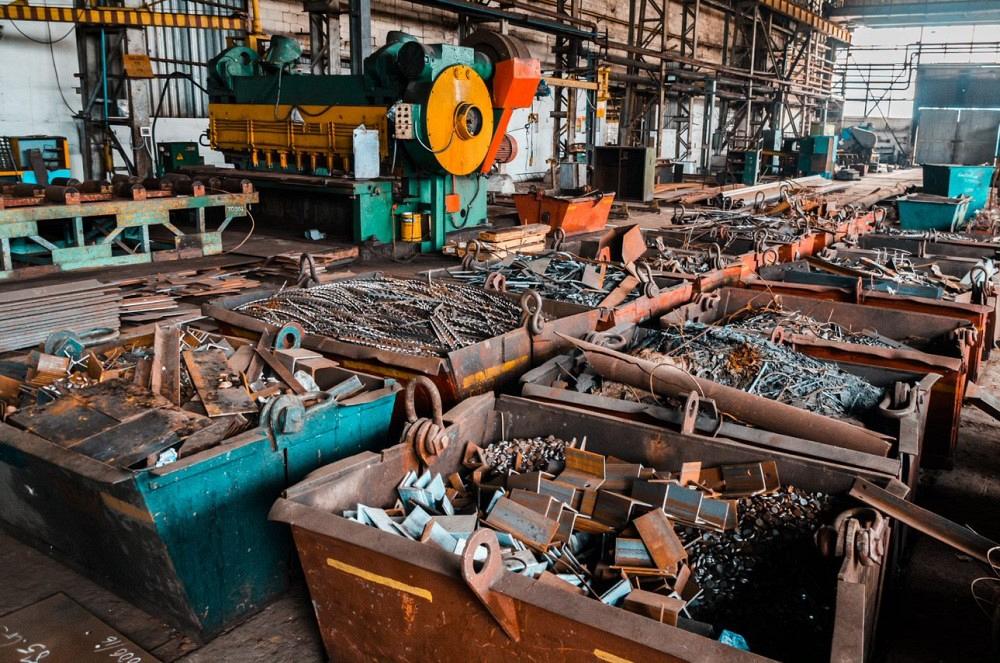Sales and Marketing Director
- FMA
- The Fabricator
- FABTECH
- Canadian Metalworking
Categories
- Additive Manufacturing
- Aluminum Welding
- Arc Welding
- Assembly and Joining
- Automation and Robotics
- Bending and Forming
- Consumables
- Cutting and Weld Prep
- Electric Vehicles
- En Español
- Finishing
- Hydroforming
- Laser Cutting
- Laser Welding
- Machining
- Manufacturing Software
- Materials Handling
- Metals/Materials
- Oxyfuel Cutting
- Plasma Cutting
- Power Tools
- Punching and Other Holemaking
- Roll Forming
- Safety
- Sawing
- Shearing
- Shop Management
- Testing and Measuring
- Tube and Pipe Fabrication
- Tube and Pipe Production
- Waterjet Cutting
Industry Directory
Webcasts
Podcasts
FAB 40
Advertise
Subscribe
Account Login
Search
5 ways to handle stamping, die cutting waste streams automatically
Build operational resiliency by automating waste removal in metal forming operations
- By Mike Hook
- November 17, 2020
- Article
- Materials Handling

With fewer human resources on the shop floor, metal forming operations that automate waste streams and leverage the industrial internet of things (IIoT) will be more efficient for a more resilient future and safer workplace. Images provided
As the manufacturing sector regroups from the disruption caused by COVID-19, one thing has become clear: Skilled worker shortages will continue to escalate, and stamping operations need to prepare and adapt to meet this challenge.
A recent survey by a major manufacturing technologies company reported that 21% of respondents said automation is an area in which COVID-19 revealed opportunities for innovation. With fewer human resources on the shop floor, metal forming operations that automate waste streams and leverage the industrial internet of things (IIoT) will be more efficient for a more resilient future. Also, because automation supports physical distancing of employees and reduces contact with equipment and tools overall, it also enhances workplace safety.
Five areas in which adding automation to stamping and diemaking processes not only help mitigate the existing lack of skilled labor but position stamping manufacturers for growth down the road are related to scrap, fluid management, and monitoring.
1. Move Metal Scrap
Conveyors, hydraulic dumpers, and automated loadout systems eliminate some of the most laborious manual processes in metal scrap handling.
Conveyors. Conveyors remove stamping scrap and debris quickly and automatically from the point of production. When metal waste and spent cutting fluid are cleared from core operations automatically, forklift transfer is eliminated and production cycles are optimized.
Automatic dumpers. These accept chip carts or drums from die machining operations and elevate and invert them over a receiving hopper. Mechanical options are equipped for high-level transfers; hydraulic systems facilitate low-level metal scrap transfers. If a hand-held control is used for directing the operation, both systems empower efficient, one-person cart unloading.
Loadout systems. These systems automatically transfer metal scrap into distribution containers for transport to a metal recycler. A shuttle conveyor’s continuous back-and-forth operation evenly distributes scrap in containers. Level sensors provide operators with an alert when the container is filled to capacity. Loadout automation can even send a signal to the scrap dealer using machine-to-machine communication that the container is ready for pickup. Integral scales track overall scrap output and help ensure that containers are full but do not exceed road weight limits as well. These systems significantly minimize the oversight needed for efficient loadouts.
Automating the transfer of metal scrap from one point of production to another minimizes employee intervention. Also, workplace safety is improved because these systems eliminate the dangers associated with moving metal scrap manually. This can help attract and retain quality employees, while enabling resource allocation for production-focused tasks in other areas of operation.
2. Modify Metal Scrap
Metal scrap processing equipment automates the task of reducing turnings and bushy wads of metal scrap into flowable, shovel-grade chips. Equipment with vertical feeds provides continuous positive feed operation to facilitate high-volume scrap reduction. Equipment with horizontal feeds can accommodate low volumes of stringy and bulky turnings.
These systems help keep shop floors free of hazardous materials and prepare the metal scrap for more efficient and effective processing down the line.
3. Monitor Machines
With older, experienced workers leaving the workforce, automated machine monitoring and IIoT capabilities present a way for stampers to succeed when that acute knowledge of facility equipment and maintenance resources are in short supply. Continuously monitoring equipment performance and capturing that data, automated machine monitoring systems support predictive maintenance. That ultimately minimizes shutdowns, lowers maintenance through reduced labor overhead, increases productivity, and improves workplace safety over the entire operation.
Because IIoT communication devices gather equipment data and send it to the cloud, they make equipment data accessible to any person or device, anywhere. This can help a new operator review what has caused a machine to fail in the past and help make machine uptime more predictable. IIoT can even email vendors to order replacement parts automatically.
4. Separates Cutting Fluid
Post die-cutting operations, wringers, and centrifuges separate cutting fluids from metal chips. Particularly when they are incorporated into a metal chip processing system, wringers and centrifuges facilitate automatic removal and recovery of cutting fluids to help speed up waste stream management. Wringers and centrifuges with self-cleaning designs and auto lube systems that automatically grease bearings help support continuous operation while reducing operator-led procedures.
5. Manage Cutting Fluid
For shops that lack automated fluid filtration systems, cutting fluid management demands repeated intervention from employees. Operations that use tramp-oil separators eliminate the need to vacuum oil from rinse tanks manually. By automatically removing free-floating and mechanically dispersed tramp oils, bacteria, slime, and inverted emulsions from individual machine sumps, central systems, and wash tanks, tramp-oil separators can reduce tramp oil to less than 1% in a single pass.
Turnkey centralized fluid filtration systems can take fluid management efficiency even further through automated coolant concentration control and continuous bacteria elimination via ozone injection. These centralized systems require minimal operator involvement and training, making fluid management effortless, seamless, and easy. Cutting fluid recycling equipment also reduces hazardous waste handling up to 90% and reduces new fluid purchases by as much as 75%.

Loadout systems automatically transfer metal scrap into distribution containers for transport to a metal recycler.
Automation Not a Job-Killer
Although automation presents a path to future resiliency, it continues to be haunted by a stigma from the past. To fully leverage the level of innovation that automation offers, the North American manufacturing sector—including metal forming operations—must first extinguish the misconception that automation only eliminates jobs, when in fact is it shown to help create new jobs. A Deloitte study of automation in the U.K. indicated that although 800,000 low-skilled jobs were eliminated, 3.5 million higher-paying jobs were created.
Companies that deploy automated technologies in their operations tend to grow, while those that don’t tend to wither. As such, automating waste streams is a pathway to progress for North American stamping companies and their employees, and to operational resiliency that will position plants for growth even in the most challenging economic conditions.
Mike Hook is sales and marketing director for PRAB.
About the Author
Related Companies
subscribe now

The Fabricator is North America's leading magazine for the metal forming and fabricating industry. The magazine delivers the news, technical articles, and case histories that enable fabricators to do their jobs more efficiently. The Fabricator has served the industry since 1970.
start your free subscription- Stay connected from anywhere

Easily access valuable industry resources now with full access to the digital edition of The Fabricator.

Easily access valuable industry resources now with full access to the digital edition of The Welder.

Easily access valuable industry resources now with full access to the digital edition of The Tube and Pipe Journal.
- Podcasting
- Podcast:
- The Fabricator Podcast
- Published:
- 04/16/2024
- Running Time:
- 63:29
In this episode of The Fabricator Podcast, Caleb Chamberlain, co-founder and CEO of OSH Cut, discusses his company’s...
- Industry Events
16th Annual Safety Conference
- April 30 - May 1, 2024
- Elgin,
Pipe and Tube Conference
- May 21 - 22, 2024
- Omaha, NE
World-Class Roll Forming Workshop
- June 5 - 6, 2024
- Louisville, KY
Advanced Laser Application Workshop
- June 25 - 27, 2024
- Novi, MI

































